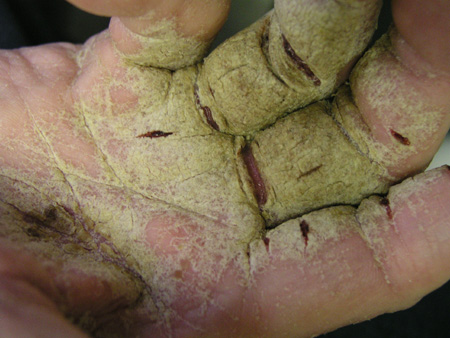History and exam
Key diagnostic factors
common
infants, children, and older adults
Infants and children are particularly liable to infection from close contact with other children and adults at home and at school.[11] Children and older adults are likely more susceptible to infection due to relatively weaker immune systems.
history of overcrowding
Patients may report recently having been in nursing homes, hospitals, long-term care facilities, prisons, or schools.[6]
history of itching in family members or close contacts over the same period
Often family members and close contacts will be similarly affected. In addition, sexual contact with new or multiple partners is a risk factor.
generalized and intense pruritus, typically worse at night
Pruritus, the result of a hypersensitivity reaction to the saliva, eggs, and fecal material of the mites, is the hallmark of scabies.
burrows
Pathognomonic; wavy, thread-like whitish-gray lines on the skin surface that may have a small vesicle with a black dot at the end; most commonly found on the fingers, wrists, and penis. [Figure caption and citation for the preceding image starts]: Characteristic linear burrows in skinFrom the collection of Laura Ferris, MD, PhD [Citation ends].
papules, vesicles, excoriations
Symmetric erythematous papules, vesicles and excoriations of the web spaces, axillae, areola, periumbilical areas, and male genitalia; typically spares the face in adults.
positive ink burrow test
The ink burrow test can also be useful in making a diagnosis.[14] A suspected lesion is marked with a purple surgical marking pen. The ink is then wiped away with isopropyl alcohol and reveals a linear burrow in cases of scabies.
Other diagnostic factors
common
papules on face, neck, palms, and soles in children
Although uncommon in adults, lesions on the face and neck are relatively common in children.
uncommon
immunosuppression
bullae
Rare presentation, but scabies has been reported to mimic bullous pemphigoid clinically in some cases.[20]
thick, crusted lesions occurring on elbows, knees, hands, and feet with dystrophic nails
Manifestation of Norwegian/crusted scabies, more common in immunosuppressed patients and patients with developmental disabilities such as Down syndrome. Lymphadenopathy and eosinophilia may be present. Very contagious, given the high parasite burden.[5][Figure caption and citation for the preceding image starts]: Hyperkeratotic palms in a patient with Norwegian scabiesPhotograph courtesy of Joseph C. English, III, MD [Citation ends].
nodules
Violaceous pruritic nodules of the axillae, groin, and male genitalia. Represent a hypersensitivity reaction to mite antigens and may persist weeks or months after treatment.[5][Figure caption and citation for the preceding image starts]: Penile nodules, characteristic of scabiesPhotograph courtesy of Joseph C. English, III, MD [Citation ends].
Risk factors
strong
overcrowded living conditions/poverty
Like other infectious diseases, scabies is transmitted by contact, and thus it is a disease of overcrowding and poverty, which are often concomitant.[7]
One Brazilian study showed that scabies was twice as prevalent in a crowded urban housing development than in a rural fishing community where families lived in larger homes, despite similar socioeconomic status of both populations.[8] Scabies is endemic in impoverished communities such as underprivileged suburban villages where up to 9% of the population and 19% of those attending a primary health care center are infested.[9]
living in close quarters with others who are infected
age under 15 or over 65 years
Infants and children are particularly liable to infection from close contact with other children and adults at home and at school.[11] Children and older adults are likely more susceptible to infection due to relatively weaker immune systems.
sexual contact with new or multiple partners
In adults, sexual contact is a relatively common mode of transmission.[9]
immunosuppression
Patients with immunosuppressive conditions, such as HIV, human T-cell leukemia virus type 1 (HTLV-1), T-cell lymphoma and leukemia, and leprosy, or those who are on immunosuppressive medications, are at risk for the development of crusted or Norwegian scabies due to impaired cell-mediated immunity.[12]
weak
poor hygiene
The role of poor hygiene may be overestimated. Scabies is not influenced by hygiene practices or the availability of water. This is demonstrated by outbreaks in institutions where high standards of hygiene exist and by the regular occurrence of scabies among Kuna Indians in Panama, a population in which strict daily personal hygiene is traditional.[7]
contact with an infected animal
Wild and domestic animals rarely transmit scabies to humans. In these cases, the mites do not usually live longer than a few days, and the infestation is self-limited.[6]
contact with contaminated clothing, towels, and bedding
Despite common belief, scabies is only infrequently acquired from contaminated clothing, towels, and bedding. One study showed that direct person-to-person body contact was necessary for transmission of scabies. Only 4 new cases resulted from 272 attempts to infect volunteers who climbed into beds just vacated by patients infected with scabies.[13] This suggested that clothing or mites shed on the floor were an unlikely means of infestation in classic scabies. However, this study was limited to young adults, and so it is possible that these means of spread are more important in pediatric or older patients.
winter season
In an epidemiologic study of the UK, scabies was more prevalent in the winter than in summer. Greater frequency of outbreaks in the winter may be due to the fact that mites survive longer away from the body in cooler weather, and colder weather encourages overcrowding in human beings. Mites may also be sensitive to antimicrobial peptides contained in human sweat, resulting in reduced infestation in warm weather.[9]
Use of this content is subject to our disclaimer